MAGEA4:黑色素瘤相关抗原(MAGE)家族成员,肿瘤特异性免疫研究热门靶点!
日期:2023-11-08 13:17:40
加拿大生物公司AbCellera在AACR 2023年年会上展示了针对MAGE-A4的T细胞诱导剂(TCE)平台的最新数据。TCE是一种双特异性抗体,能够同时结合肿瘤杀伤性T细胞和肿瘤靶点,引导免疫系统识别并消除癌细胞。AbCellera详细描述了针对一种经过验证的肽-主要组织相容性复合物(pMHC)肿瘤靶点的高特异性和可开发性抗体的发现。通过充分利用TCE针对携带肿瘤特异性抗原的pMHC,可以激活对这一通常难以靶向的MAGE-A4肿瘤靶点的免疫效应。
黑色素瘤相关抗原4(MAGE-A4)属于MAGE-As亚家族成员。MAGE-As在一系列恶性肿瘤中广泛表达,显示了肿瘤靶向免疫研究的巨大潜力。目前,MAGE-A亚家族中研究最为深入的是MAGE-A1和MAGE-A3,对于其它成员的研究还较少。因MAGE-As蛋白具有很强的抗原同源性,特异性较弱,较难获得特异性抗体。这给MAGE-A亚家族蛋白表达的研究带来了困难。目前,许多学者已经开始研制特异性更强的单克隆抗体,进一步探索MAGE家族蛋白在肿瘤特异性免疫研究中的价值!
1. 什么是黑色素瘤相关抗原(MAGE)?
黑色素瘤相关抗原(Melanoma antigen,MAGE)家族是一个复杂的大家庭,分为两个亚类,即MAGE-I类和MAGE-II类 (图1) [1]。MAGE-I类抗原为肿瘤特异性抗原(Tumor-Specific Antigen,TSA),属于癌睾丸抗原中的一个大家族,主要分布在生殖细胞和滋养细胞上,包括MAGE-A、B和C三个亚家族。MAGE-II类抗原,在人体正常的细胞中可见其表达,成员有MAGE-D、E、F、G、H及L等亚科,其不属于癌睾丸抗原的范畴。其中,MAGE-As家族包括MAGE-A1~MAGE-A15共15个成员,人类许多其它组织来源的肿瘤都至少表达一种MAGE-A基因。因此,MAGE-A作为一种肿瘤特异性的抗原得到广泛关注,已成为多种肿瘤靶向免疫的重要靶点 [1-5]。
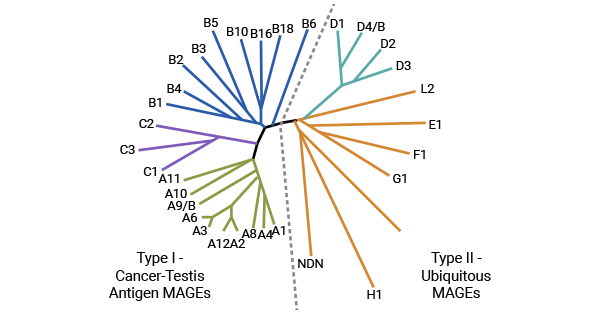
图1. 黑色素瘤相关抗原MAGE家族 [1]
2. 什么是MAGE-A4?
黑色素相关抗原A4(Melanoma-associated antigen 4,简称MAGEA4或MAGE-A、MAGE4)是一种肿瘤/睾丸组织中抗原,属于MAGE-As蛋白家族亚型。MAGE-As亚家族主要位于X染色体q28区域,长约45kb,有3个外显子,其中第1、2号外显子很短,第3号外显子较长。MAGE-A编码一个309-319个氨基酸的蛋白质(图2) [1]。MAGE-A在细胞内可被加工成抗原肽,与HLA-I类分子相结合形成复合物,通过MHC I类分子提呈给CD8+T细胞,在肿瘤患者体内诱发肿瘤特异性免疫应答。目前,MAGE-As亚家族蛋白水平的研究相对于基因水平的研究较少 [6-8]。
MAGE-A4在正常组织中仅在睾丸和胎盘表达,但在多种癌症细胞中广泛存在。MAGE家族是首个发现的癌胚抗原,激发了针对肿瘤细胞的特异性免疫研究,其中MAGE-A亚家族研究最为广泛。研究表明MAGE-A基因可以激活特异性T淋巴细胞,促使其攻击肿瘤细胞。而超过一半的肿瘤表达MAGE基因,因此,研究MAGE-A家族对于肿瘤的免疫研究具有重要意义 [9-11]。
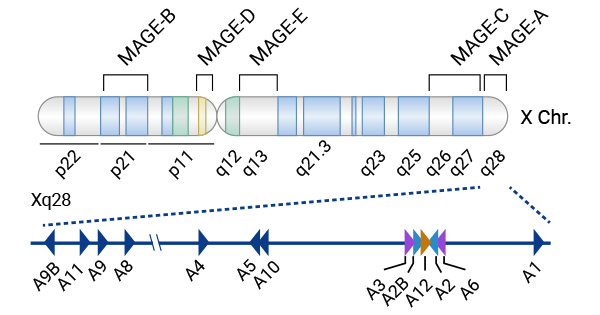
图2. MAGE-As亚家族主要位于X染色体q28区域 [1]
3. MAGE-A4在肿瘤中的相关调控机制
MAGE-A4所表现出与家族其他成员不同的生物学特,MAGE-A4具有以下特点而被优先当做肿瘤疫苗的靶抗原:(1)它含有的肽段可以与特定的MHC分子相结合;(2)肽MHC与MAGE-A4所形成的复合物,可以与特定的T细胞受体结合并促进并激活特异性T细胞杀伤肿瘤细胞。目前对MAGE-A4的研究较少,MAGE-A4在肿瘤中的调控机制,很大程度上仍然是个未知数,但是越来越多的证据暗示了MAGE-A4参与了细胞凋亡和细胞周期进程 [11-19]。
研究发现,MAGE-A4与抑癌基因P53呈正相关,其C端107个氨基酸片段(MAGE-A4DeltaN1)通过与Miz-1部分结合可诱导P53-依赖和P53-非依赖的独立机制,增强了P53的转录活性,但是减少了p21(Cip1)转录子和蛋白水平。p53基因是重要的抑癌基因,可促使癌细胞凋亡并控制细胞周期。因此,MAGE-A4蛋白表现出的抑制肿瘤进展的生物学活性,提示该蛋白可以保护机体免受肿瘤的攻击(图3) [13]。同时也有研究提示Twist1的增强子与MAGE-A4的启动子以非直接方式结合,从而使MAGE-A4扩增。然而,另外的研究提示MAGE-A4可以活化跨损伤DNA合成(Trans-lesion synthesis,TLS)途径的活化,抑制对正常细胞的损伤修复,而选择性活化化疗细胞DNA损伤修复,造成肿瘤细胞损伤的修复,从而引起肿瘤细胞对化疗药的耐药 [11]。
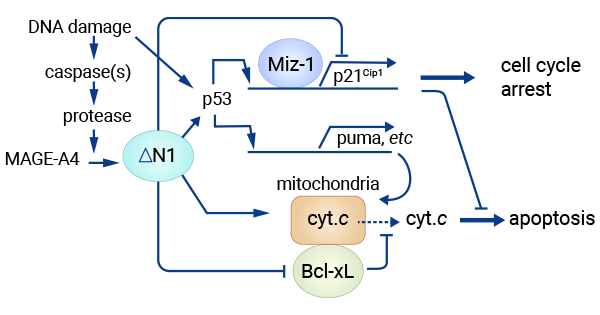
图3. MAGE-A4和Miz-1部分结合可诱导P53-依赖和P53-非依赖的独立机制 [13]
4. MAGE-A4在肿瘤中的作用
MAGE-A家族成员表达于多种类型的肿瘤组织,如肝癌、非小细胞肺癌、膀胱癌、外阴癌、结直肠肿瘤、唾液腺肿瘤、宫颈癌等 [4-5,20-21]。最近的研究结果证实了MAGE-A4在乳腺癌、胶质瘤、食管鳞癌、前列腺癌、甲状腺癌以及口腔鳞状细胞癌等多种恶性肿瘤中的表达 [10-11,22-23]。这一广泛的分布提示了MAGE-A4在多种肿瘤类型中可能具有重要的生物学功能和临床意义。
4.1 MAGE-A4和乳腺癌研究
研究发现,在三阴性乳腺癌(TNBC)中,MAGE-A4的阳性率为35.21%,高于非三阴性乳腺癌。此外,研究指出MAGE-A4表达与肿瘤临床分期相关,随着临床分期升高,其阳性表达率下降,可能在肿瘤进展中发挥抑制作用。MAGE-A家族成员和NY-ESO-1在乳腺癌中被确认为肿瘤相关抗原,与雌激素受体(ER)的表达呈正相关。同时,MAGE-As的表达与乳腺癌不良预后指标HER-2呈正相关。此外,MAGE-A4能够激活体内CD4+T细胞,促进机体免疫反应,有可能在肿瘤早期通过免疫反应杀死肿瘤细胞。这些研究结果表明MAGE-A4有望成为TNBC的潜在靶点 [22]。
4.2 MAGE-A4和胶质瘤研究
研究发现MAGE-A4在胶质瘤中表达与正常脑组织相比差异有统计学意义。MAGE-A4具有在睾丸组织之外正常体细胞不表达的特点,这为MAGE-A4作为特异性靶抗原应用到胶质瘤免疫研究提供了理论依据。MAGE-A4 mRNA在高级别胶质瘤(Ⅲ~Ⅳ级)中表达明显高于低级别胶质瘤(Ⅰ~Ⅱ级),这表明MAGE-A4可能与胶质瘤恶性分化相关,可作为评估恶性程度的参考指标,或用于评估胶质瘤患者的KPS评分和病理分级。MAGE-A4在脑胶质瘤组织中有特异性表达,并且与病理级别显著相关,而在正常脑组织中没有表达。因此,MAGE-A4可以作为脑胶质瘤免疫研究的理想靶点 [23, 25]。
4.3 MAGE-A4和食管鳞癌研究
实验采用qPCR和免疫组化的方法分别检测,研究人员发现在食管鳞癌中,MAGE-A4的表达率高达50%,而在不典型组织和正常食管黏膜中表达水平较低。这一发现不仅突显了MAGE-A4基因在食管鳞癌中的严格肿瘤表达特异性,而且证实了其在食管鳞癌发展中的潜在作用。因此,MAGE-A4基因可以作为食管鳞癌特异性标志物,为准确临床研究提供了有力依据。随着肿瘤特异性标志物在临床中的逐步应用,其对大多数恶性肿瘤的效果产生积极影响,为后续临床研究提供有效支持 [27-28]。
4.4 MAGE-A4和其它肿瘤研究
研究表明MAGE-A4在多种肿瘤中发挥重要作用。例如,利用小RNA使肺鳞癌细胞系H1703中的MAGE-A4基因表达沉默后,caspase-3活性下降了58% [28]。另一项研究针对直肠癌患者展示了MAGE-A4抗原肽治疗的有效性,导致患者肿瘤生长速度及癌胚抗原显著降低 [29]。此外,针对187例非小细胞肺癌患者的研究表明,组织中MAGE-A4的表达可能导致人白细胞抗原HLA的丢失,进而导致患者的5年生存率显著下降 [30]。在食管癌组织中,MAGE-4,MAGE-12和NY-ESO-1呈现不同程度的表达,而在食管癌旁的正常组织中则不表达 [31]。此外,MAGE-A与前列腺癌中的AR形成分子桥,促进AR的转录活性,进而促进AR依赖性前列腺癌的生长 [4, 32]。
5. MAGE-A4临床研究前景
目前,有19种针对MAGEA4的药物在临床研究中,其中最高阶段的是Afamitresgene Autoleucel(艾基奥仑赛),一种TCR细胞疗法,已经进入三期临床试验,用于治疗滑膜肉瘤,食管癌和粘液样脂肪肉瘤等。其他药物的类型包括双特异性抗体,重组蛋白,细胞疗法,融合蛋白和T细胞疗法等。这些药物的共同靶点是MAGE-A4,部分药物还针对其他靶点,如CD3,MAGEA8,NY-ESO-1,PRAME,SSX2,survivin,WT1,HLA-A 24,CCL19,IL-7等。
基于MAGEA4靶点的药物作用机制主要是通过调节或抑制MAGEA4或其他靶点的表达或功能,来诱导肿瘤细胞的凋亡或抑制肿瘤的生长和转移。部分药物还通过增强免疫系统的反应或替代损伤的细胞来发挥作用。这些药物的在研适应症主要是各种类型的肿瘤,如黑色素瘤,膀胱癌,非小细胞肺癌,头颈部肿瘤等。部分药物还有其他在研适应症,如血液及淋巴系统疾病,消化系统疾病,呼吸系统疾病等。MAGEA4靶点药物的研发展示了其活跃性和多样性,也凸显了该靶点在肿瘤免疫研究中的重要地位和前景。
为鼎力协助科研和药企人员针对MAGEA4的在肿瘤中的临床应用研究,CUSABIO推出MAGEA4活性蛋白(Code:CSB-MP013330HU)以及MAGEA4抗体(Code: CSB-MA013330A0m),助力您在MAGEA4机制方面的研究或其潜在临床价值的探索。
j9九游会登录入口首页 CUSABIO MAGEA4 蛋白
Recombinant Human Melanoma-associated antigen 4 (MAGEA4) (Active) Code: CSB-MP013330HU
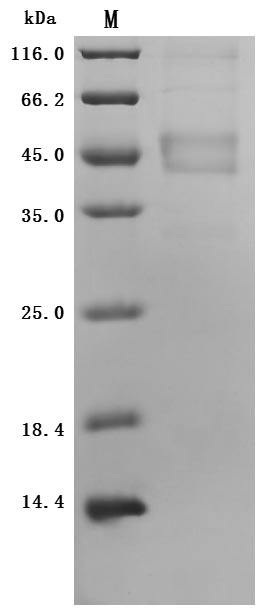
The high purity is greater than 90% as determined by SDS-PAGE.
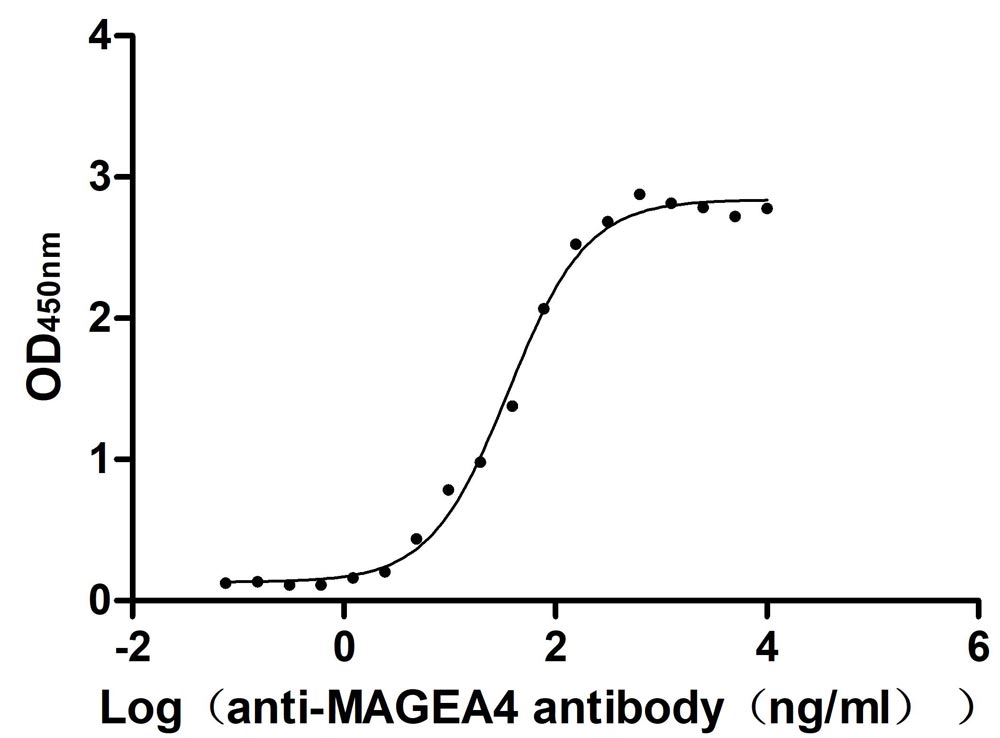
Immobilized Human MAGEA4 at 2 μg/ml can bind anti-MAGEA4 recombinant antibody. The EC50 is 30.33-43.10 ng/mL.
j9九游会登录入口首页 CUSABIO MAGEA4 抗体
参考文献:
[1] Lee, Anna K., and Patrick Ryan Potts. "A comprehensive guide to the MAGE family of ubiquitin ligases." Journal of molecular biology 429.8 (2017): 1114-1142.
[2] Chomez, Patrick, et al. "An overview of the MAGE gene family with the identification of all human members of the family." Cancer research 61.14 (2001): 5544-5551.
[3] Weon, Jenny L., and Patrick Ryan Potts. "The MAGE protein family and cancer." Current opinion in cell biology 37 (2015): 1-8.
[4] Meek, David W., and Lynnette Marcar. "MAGE-A antigens as targets in tumour therapy." Cancer letters 324.2 (2012): 126-132.
[5] Sang, Meixiang, et al. "MAGE-A family: attractive targets for cancer immunotherapy." Vaccine 29.47 (2011): 8496-8500.
[6] Aubry, Florence, et al. "MAGE‐A4, a germ cell specific marker, is expressed differentially in testicular tumors." Cancer: Interdisciplinary International Journal of the American Cancer Society 92.11 (2001): 2778-2785.
[7] Hagiwara, Yoshio, et al. "Consequences of point mutations in melanoma-associated antigen 4 (MAGE-A4) protein: Insights from structural and biophysical studies." Scientific reports 6.1 (2016): 25182.
[8] Sun, Qian, et al. "T-cell receptor gene therapy targeting melanoma-associated antigen-A4 by silencing of endogenous TCR inhibits tumor growth in mice and human." Cell death & disease 10.7 (2019): 475.
[9] Chambost, Hervé, et al. "Expression of gene MAGE-A4 in Reed-Sternberg cells." Blood, The Journal of the American Society of Hematology 95.11 (2000): 3530-3533.
[10] Kocher, Thomas, et al. "Prognostic relevance of MAGE‐A4 tumor antigen expression in transitional cell carcinoma of the urinary bladder: a tissue microarray study." International journal of cancer 100.6 (2002): 702-705.
[11] Gao, Yanzhe, et al. "A neomorphic cancer cell-specific role of MAGE-A4 in trans-lesion synthesis." Nature communications 7.1 (2016): 12105.
[12] Saito, Takuro, et al. "High expression of MAGE-A4 and MHC class I antigens in tumor cells and induction of MAGE-A4 immune responses are prognostic markers of CHP-MAGE-A4 cancer vaccine." Vaccine 32.45 (2014): 5901-5907.
[13] Sakurai, Toshiharu, et al. "A cleaved form of MAGE-A4 binds to Miz-1 and induces apoptosis in human cells." Journal of Biological Chemistry 279.15 (2004): 15505-15514.
[14] Cruz, Conrad R., et al. "Improving T-cell therapy for relapsed EBV-negative Hodgkin lymphoma by targeting upregulated MAGE-A4." Clinical Cancer Research 17.22 (2011): 7058-7066.
[15] Sanderson, Joseph P., et al. "Preclinical evaluation of an affinity-enhanced MAGE-A4-specific T-cell receptor for adoptive T-cell therapy." Oncoimmunology 9.1 (2020): 1682381.
[16] Takahashi, Norihiko, et al. "First clinical trial of cancer vaccine therapy with artificially synthesized helper/killer‐hybrid epitope long peptide of MAGE‐A4 cancer antigen." Cancer science 103.1 (2012): 150-153.
[17] Kageyama, Shinichi, et al. "Adoptive transfer of MAGE-A4 T-cell receptor gene-transduced lymphocytes in patients with recurrent esophageal cancer." Clinical Cancer Research 21.10 (2015): 2268-2277.
[18] Okumura, Satoshi, et al. "Chimeric antigen receptor T-cell therapy targeting a MAGE A4 peptide and HLA-A* 02: 01 complex for unresectable advanced or recurrent solid cancer: protocol for a multi-institutional phase 1 clinical trial." BMJ open 12.11 (2022): e065109.
[19] Kobayashi, Hiroshi, et al. "The biology of uterine sarcomas: a review and update." Molecular and clinical oncology 1.4 (2013): 599-609.
[20] Tsai, Jong-Rung, et al. "Differential expression profile of MAGE family in non-small-cell lung cancer." Lung cancer 56.2 (2007): 185-192.
[21] Dhodapkar, Madhav V., et al. "Expression of cancer/testis (CT) antigens MAGE-A1, MAGE-A3, MAGE-A4, CT-7, and NY-ESO-1 in malignant gammopathies is heterogeneous and correlates with site, stage and risk status of disease." Cancer Immunity 3.1 (2003).
[22] Cabezon, Teresa, et al. "Proteomic profiling of triple-negative breast carcinomas in combination with a three-tier orthogonal technology approach identifies Mage-A4 as potential therapeutic target in estrogen receptor negative breast cancer." Molecular & Cellular Proteomics 12.2 (2013): 381-394.
[23] Two-Pronged, A. "471. CMV-Specific HER2-Redirected T Cells for the Adoptive Immunotherapy of Glioblastoma." Molecular Therapy 18 (2010): 1.
[24] Guo, Liru, et al. "The expression and clinical significance of melanoma‑associated antigen‑A1,‑A3 and‑A11 in glioma." Oncology letters 6.1 (2013): 55-62.
[25] Ebrahimabadi, S., et al. "MAGE-A4-CAR-NK CELL THERAPY FOR THE TREATMENT OF SOLID TUMORS." Hematology, Transfusion and Cell Therapy 45 (2023): S534-S535.
[26] Chen, Xiaohua, et al. "Analysis of the function of MAGE-A in esophageal carcinoma by bioinformatics." Medicine 98.21 (2019).
[27] Ueda, Shugo, et al. "NY-ESO-1 antigen expression and immune response are associated with poor prognosis in MAGE-A4-vaccinated patients with esophageal or head/neck squamous cell carcinoma." Oncotarget 9.89 (2018): 35997.
[28] Peikert, Tobias, et al. "Melanoma antigen A4 is expressed in non–small cell lung cancers and promotes apoptosis." Cancer research 66.9 (2006): 4693-4700.
[29] Liu, Fangfang, et al. "A study of protein expression of MAGE-A3, MAGE-A4 and MAGE-A10 genes in colorectal carcinoma and its clinical significance." Chinese Journal of General Surgery (2012): 37-39.
[30] Baba, Tetsuro, et al. "Clinical significance of human leukocyte antigen loss and melanoma-associated antigen 4 expression in smokers of non-small cell lung cancer patients." International journal of clinical oncology 18 (2013): 997-1004.
[31] Zhang, Yujie, Yuxin Zhang, and Li Zhang. "Expression of cancer–testis antigens in esophageal cancer and their progress in immunotherapy." Journal of cancer research and clinical oncology 145 (2019): 281-291.
[32] Bergeron, Alain, et al. "High frequency of MAGE‐A4 and MAGE‐A9 expression in high‐risk bladder cancer." International Journal of Cancer 125.6 (2009): 1365-1371.











